I haven't provided detailed commentary on the US labour market for a while now. To…
Australian labour market – slight improvement but uncertainty continues
The Australian Bureau of Statistics (ABS) released the latest labour force data today (August 14, 2025) – Labour Force, Australia – for July 2025, which reveals that last month’s gloom might not have been the start of a downward trend. The current data has blurred that outlook and the best we can say is that the future is uncertain. The virtuous three were evident this month: rising employment (particularly full-time), constant participation, and falling unemployment. Underemployment also fell 0.1 point as a result of the strong full-time employment result. It remains a fact that with 10.1 per cent of available labour not being used it is ludicrous to talk about Australia being close to full employment. There is substantial scope for more job creation given the slack that is present.
The summary seasonally-adjusted statistics for July 2025 are:
- Employment rose 24,500 (0.2 per cent).
- Full-time employment rose 60.5 thousand (0.6 per cent).
- Part-time employment fell 35.9 thousand (-0.8 per cent).
- Unemployment fell 10,200 (-1.5 per cent) to 649,000.
- The unemployment rate fell 1 point to 4.2 per cent.
- The participation rate was steady on 67 per cent.
- The Employment-population ratio was steady on 64.2 per cent.
- Monthly hours worked rose 6.3 million (0.32 per cent).
- Underemployment fell 0.1 point to 5.9 per cent (falling 16.3 thousand to 896.4 thousand).
- The Broad Labour Underutilisation rate (the sum of unemployment and underemployment) fell 0.2 points to 10.1 per cent.
- Overall, there are 1543.3 thousand people either unemployed or underemployed.
The ABS press release – Unemployment rate falls to 4.2% as female participation hits record high in July – noted that:
The seasonally adjusted unemployment rate fell to 4.2 per cent in July …
Growth in employment was driven by full-time employment, which was up by 60,000 people, with a 36,000 person fall in part-time employment partly offsetting this rise. Female full-time workers grew by 40,000 while male full-time workers rose by 20,000.
The growth in employment resulted in the employment-to-population ratio rising slightly to 64.2 per cent. The participation rate stayed at 67.0 per cent. The female employment-to-population ratio and participation rate reached 60.9 per cent and 63.5 per cent respectively, both new historical highs …
The underutilisation rate, which combines the unemployment and underemployment rates, fell by 0.2 percentage points to 10.1 per cent. This was 0.4 percentage points lower than July 2024, and 3.8 percentage points lower than March 2020.
Summary
1. A slight reversal on last month’s deteriorating outcome – but monthly figures move around so it is really too early to tell which way the labour market is heading.
2. The large drop in full-time employment last month was reversed.
3. There is now 10.1 per cent of the available and willing labour supply being wasted despite the modest drops in the official unemployment rate and underemployment.
Employment growth stronger in July
- Employment rose 24,500 (0.2 per cent).
- Full-time employment rose 60.5 thousand (0.6 per cent).
- Part-time employment fell 35.9 thousand (-0.8 per cent).
The following graph shows the growth in total, full-time, and part-time employment for the last 24 months.
The following table shows the shifts over the last 6 months which helps to see the underlying trend.
The Employment-to-Population ratio provides a measure of the state of the labour market that is independent of the supply shifts in the labour market (driven by the shifts in the participation rate).
The underlying working age population grows steadily while the labour force shifts with both underlying population growth and the participation swings.
The following graph shows the Employment-Population ratio was steady at 64.2 – which provides some counter to the other variables that are indicating a systematic slowdown is underway.
The next graphs show the average monthly change in total employment (first graph) and full- and part-time employment (second graph).
For total employment the monthly average changes were:
- 2022 – 44.8 thousand
- 2023 – 30.8 thousand
- 2024 – 33 thousand
- 2025 so far – 16.2 thousand
Monthly hours worked rose 6.3 million (0.32 per cent) in July 2025
A slight recovery from last month.
The following graph shows the growth in monthly hours worked for the last 24 months, with the straight line being a simple linear regression to indicate trend.
Unemployment fell 10,200 (-1.5 per cent) to 649,000 in July
A good outcome – full-time employment rising, participation constant and unemployment declining modestly.
The following graph shows the evolution of the official unemployment rate since 1980.
Broad labour underutilisation – down 0.2 points in July
- Underemployment fell 0.1 point to 5.9 per cent (falling 16.3 thousand to 896.4 thousand).
- The Broad Labour Underutilisation rate (the sum of unemployment and underemployment) fell 0.2 points to 10.1 per cent.
- Overall, there are 1543.3 thousand people either unemployed or underemployed.
The following graph shows the evolution of underemployment and the Broad labour underutilisation rate since 1980.
Teenage labour market – improvement
- Total teenage (15-19) employment rose 23.5 thousand (2.8 per cent) in July 2025.
- Full-time employment rose by 18.6 thousand (10.5 per cent).
- Part-time employment rose 4.9 thousand (0.7 per cent).
The following table summarises the shifts in the teenage labour market for the month and over the last 12 months.
To put these changes into a scale perspective (that is, relative to size of the teenage labour force) the following graph shows the shifts in the Employment-Population ratio for teenagers.
The Teenage Employment-Population ratios and their monthly changes in July 2025 were:
- Males: 47.2 per cent unchanged
- Females: 53.3 per cent 2.6 points – significant improvement.
- Total: 50.2 per cent 1.3 points
Conclusion
My standard warning to take care in interpreting monthly labour force changes – they can fluctuate for a number of reasons and it is imprudent to jump to conclusions on the back of a single month’s data.
- Last month, it looked like there were signs of a systematic slowdown beginning to unfold in the labour market.
- However, the current data has blurred that outlook and the best we can say is that the future is uncertain.
- The virtuous three were evident this month: rising employment (particularly full-time), constant participation, and falling unemployment.
- Underemployment also fell 0.1 point as a result of the strong full-time employment result.
- It remains a fact that with 10.1 per cent of available labour not being used it is ludicrous to talk about Australia being close to full employment. There is substantial scope for more job creation given the slack that is present.
That is enough for today!
(c) Copyright 2025 William Mitchell. All Rights Reserved.
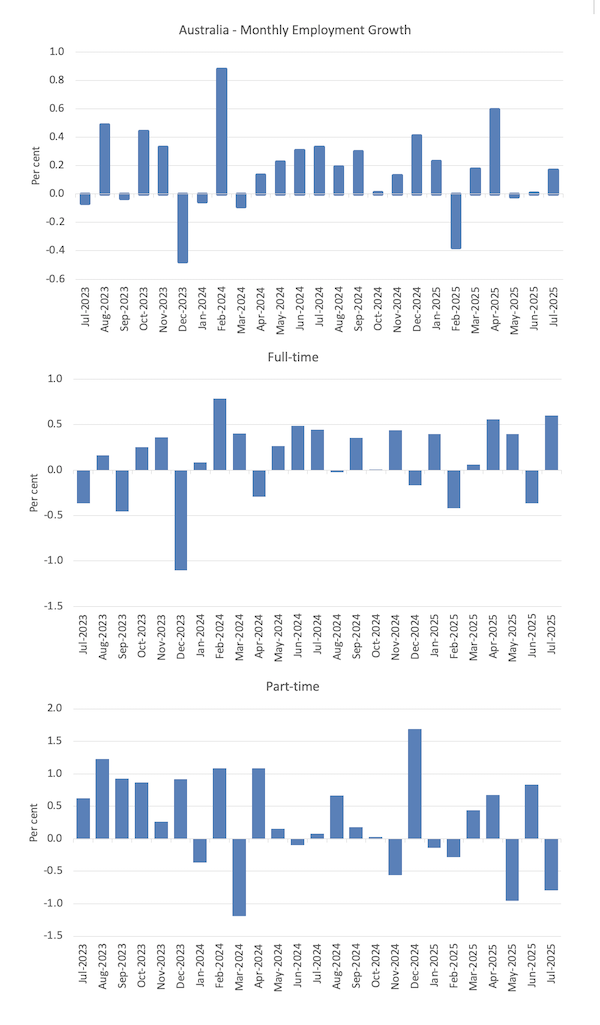
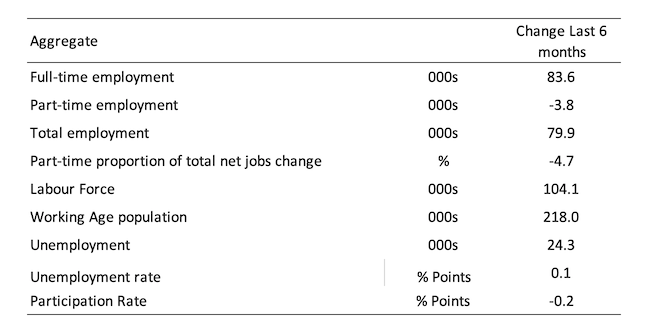
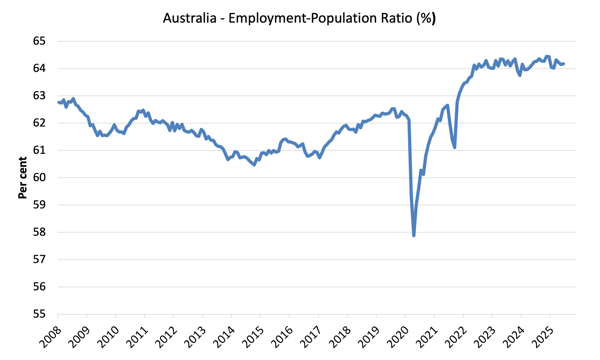
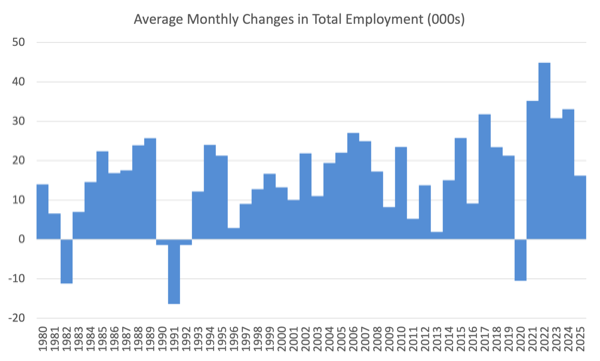
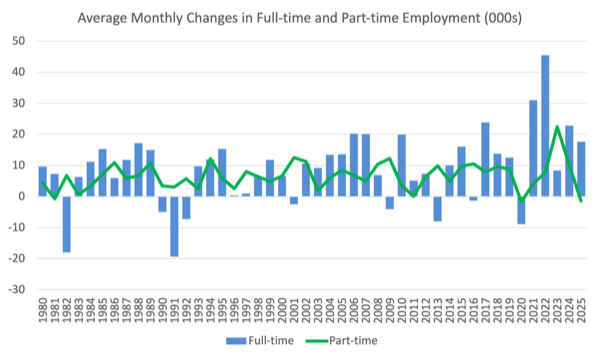
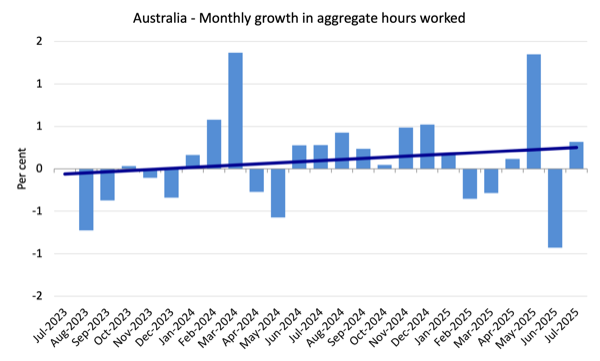

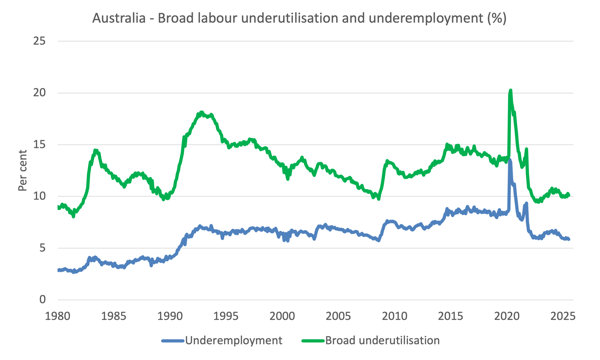
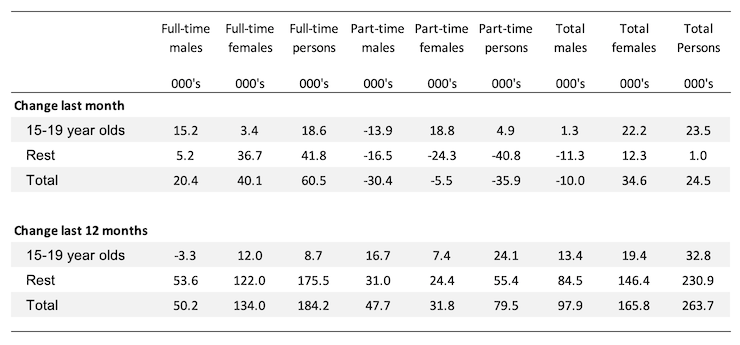
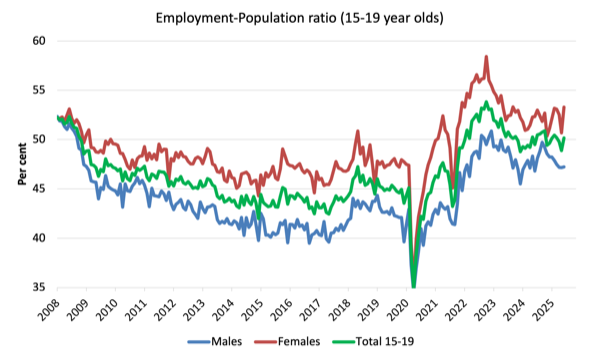
This Post Has 0 Comments